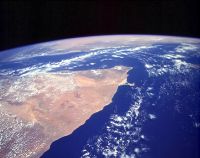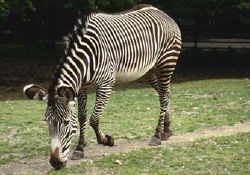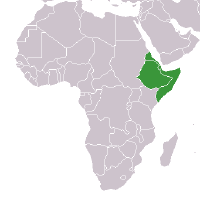Difference between revisions of "Horn of Africa" - New World Encyclopedia
(geography) |
|||
| Line 98: | Line 98: | ||
*Lewis, Brenda Ralph ed. ''Great Civilizations''. Parragon Publishing:2002. Bath, England. ISBN 0752561413 | *Lewis, Brenda Ralph ed. ''Great Civilizations''. Parragon Publishing:2002. Bath, England. ISBN 0752561413 | ||
*Woodward, Peter. ''The Horn of Africa:Politics and International Relations'' Palgrave McMillan:2003. New York, New York. ISBN 1860648703 | *Woodward, Peter. ''The Horn of Africa:Politics and International Relations'' Palgrave McMillan:2003. New York, New York. ISBN 1860648703 | ||
| + | *[http://www.summitpost.org/area/range/275215/simien-mountain.html, Hiking in the Simien Mountains] Retrieved October 13, 2007. | ||
| + | *[http://www.wildfrontiers.com/ShowProduct.asp?ProdID=24, Mountain Trekking in Ethiopia] Retrieved October 13, 2007. | ||
| + | *[http://www.biodiversityhotspots.org/xp/Hotspots/horn_africa/Pages/default.aspx, Conservation International] Retrieved October 13, 2007. | ||
{{Regions of the world}} | {{Regions of the world}} | ||
Revision as of 23:41, 13 October 2007
The "Horn of Africa" is a large extension of land that protrudes from the eastern edge of the continent of Africa, lying between the Indian Ocean to the east and the Gulf of Aden to the north. Overall, the horn of Africa is estimated to consist of over 772,200 square mile, most of which boast a semi arid to arid climate. Despite difficult living conditions in many parts of the horn of Africa, recent estimations put the population of the region at about 90.2 million.
In a more general way, the term "Horn of Africa" is also used to define a political region that consists of Djibouti, Ethiopia, Eritrea, and Somalia. Many of these countries are also included in definitions of East Africa.
Geography and climate

The Horn of Africa is primarily distinguished through a low lying arid plain called the Ethiopian Highlands, which is divided into two sections by the Rift Valley. The two distinct sections of the Ethiopian Highlands form an area previously rich in natural resources. While this area once proved a great attraction for explorers looking for frankensense and myrhh, the potential of the potential of the area has decreased in recent years. Only 5 percent of the original habitat of the Horn of Africa is intact, a fact which most environmental scientists attribute to overgrazing.
While the habitat and plant environment has changed dramatically from its original state, the Horn of Africa continues to contain a high level of native plant life. Currently, the Horn of Africa contains a large amount of heather, erica grass, and the small yellow flower commonly refered to as St. John's Wort. Unique to the region are the Bankoualé palm and the native cucumeber trees of the Socotra islands.
While much of the Horn of Africa is semiarid or arid land, the Rift Valley has punctuated the landscape with mountains and ranges. the most notable range in the region is the Simien range, one of the largest mountain ranges in Africa. This range offers a wide variety of challenges for mountiain climbers and hikers, including the daunting peak of Ras Dashen. Ras Dashen is the largest mountain peak in Ethiopia, and the forth tallest in all of Africa. The range also remains snow capped throughout the year, an unusual occurance on the African continent.
The Simien mountain range shelters much of the wildlife for the Horn of Africa, particularly predatory animals and birds that would not be able to survive in the plains. Notable inhabitants of the mountain range include the endangered Ethiopian wolf and roaming bands of Gelada baboons. Among species of birds, the Lamergeyer species of vulture often gains recognition for its wingspan, an impressive feature that can span almost 3 meters.
While the mountian range proves shelter for endangered species, the plains offer a harsh existence for animals who choose to make their home outside of the proctective mountain folds. Overall, the Horn of Africa is extremely rich with animal life, hosting a population of over 220 species of mammals. While many animals make the region their home, the landscape and harsh climate combine to threaten a difficult environment for animals to prosper. Particularly threatened in the region is the antelope population, which includes such varieties as the beira, the dibatag, the silver dikdik and the Speke’s gazelle. Unique to the region is the Grevy's zebra, which is the largest of all the zebra species. In addition to animal and bird life, the Horn of Africa is home to proportionately more native reptiles than any other region on the continent. With over 285 species, the Horn of Africa also contains an extrememly high number of native reptile species that are only found in the region. Despite the high numbers of reptiles, however, amphibians are poorly represented in the animal life of the Horn of Africa.
Access to a water source is a pressing motivation for plains wildlife, as much of the Horn of Africa recieves very little annual rainfall. Exceptions to this rule are found in the west and center of Ethiopia and the most southern region of Eritrea, where annual rainfall is boosted by heavy precipitatino during the monsoon season. Many developed areas in the region rely on the runoff from the Simien mountain range as a source of water throughout the year.

History
Early history
The Kingdom of Aksum (also known as "Axum") was a Sabean influenced state located in Ethiopia, Eritrea, northern Somalia and Yemen that thrived between the 1st and 7th centuries. Due to the Horn's strategic location, it has been used to restrict access to the Red Sea in the past.
The region was also a source of biological resources during the Antiquity: The ancient Egyptians, Greeks and Romans sent expeditions to the region for frankincense, myrrh, dragon's blood or cinnabar and took these commodities back along the Incense Route. Therefore the Romans called this region Regio Aromatica. It is believed to also contain the fabled Egyptian Land of Punt.
The Horn was also part of a network of ports that extended down the coast of Africa, from the Persian Gulf as part of a larger and ancient commerce route along the greater Indian Ocean rim.
Pre-Colonial History
Colonial History
Post Colonial history
In recent decades, the Horn of Africa has been a region continuously in crisis. Ethiopia occupies a predominant position in the Horn because of its demographic importance: about 85% of the area's population live in this country. Large part of the Horn of Africa was colonialized by Italy: Eritrea (1880-1941), Italian Somaliland (1890-1960) and Ethiopia (1936-1941). Britain established in North Somalia (British Somaliland) and France in Djibouti (French Somaliland). Yet Ethiopia's history is largely marked by conflicts between Muslims and Christians for resources and living space, as well as between nationalism and Marxism-Leninism in the modern times. The rest of the region also faces continuous wars: a civil war erupted in Somalia in 1977, resulting in the country having had no functioning national government since 1991. Sudan, with the Sudanese Civil War, represents another important source of instability for the whole region. Conflicts have also occurred in Djibouti and Eritrea.
Moreover, the region is regularly stricken by natural catastrophes, such as droughts or flood that hit rural areas particularly hard. As a result, the region has some of the world's highest levels of malnutrition and is continuously threatened with a major humanitarian crisis. Between 1982 and 1992, about two million people died in the Horn of Africa due to this combination of war and famine.
The Horn of Africa, since 2002, has been a major focus of attention by the United States, France, Germany, and eleven African nations regarding the War on Terrorism.
Economy
States of the region depend largely on a few key exports:
Culture and ethnicity
The countries of the Horn of Africa are culturally linked together. Local people have been using the plow for cultivation and kept the Arabian dromedary as domestic animals for a long time. Some important ethno-linguistic groups in the Horn of Africa are:
- In Djibouti: the Afar (Danakil) and the Somali (Issa)
- In Eritrea: the Bilen, the Afar, the Hedareb (Beni-Amer/Beja), the Kunama (Baza), the Nara (Nialetic), the Saho (Irob), the Rashaida, the Tigre, and the Tigrinya. The Jebertis are Muslim Tigrinyas who consider themselves as a separate ethnicity, but are not recognized by other sources.
- In Ethiopia: Amharas, Afars, Agaw groups, Gurages, Hamers, Hararis (also Hadere or Adere), the Irob (Catholic Sahos) Oromos, Saho, Sidamas, Somali, Tigrayans, as well as many other small groups (see also ethnicities listed at Southern Nations, Nationalities, and People's Region) .
- In Somalia: the Somali
See also
- Conflicts in the Horn of Africa
- Geography of Africa
- History of Djibouti
- History of Eritrea
- History of Ethiopia
- History of Somalia
- Land of Punt
- Compare: Cape Horn, the southernmost point of South America
External links
- History of the Horn of Africa
- Horn of Africa News Agency
- WWF- Somali Acacia-Commiphora bushlands and thickets
- Horn of Africa Biodiversity Hotspot
- African Wild Dog Conservancy's Biodiversity Hotspots Page
- CIA World Factbook: Djibouti
- CIA World Factbook: Eritrea
- CIA World Factbook: Ethiopia
- CIA World Factbook: Somalia
- A 'Child Alert' issued by UNICEF for the Horn of Africa
- Yemen Horn of Africa Link
- Combined Joint Task Force - Horn of Africa Official Website
ReferencesISBN links support NWE through referral fees
- Gray, Richard and David Birmingham. Pre-Colonial African Trade, Essays on Trade in Central and Eastern Africa before 1900. "Southern Ethiopia" Oxford University Press:1970. London, England. ISBN 019215639X
- Oliver, Roland ed. The Dawn of African History."The Kingdom of Axum". Oxford University Press:1961. London, England.
- Thompson, L.A. and J. Ferguson Africa in Classical Antiquity, Nine Studies. "Eastern Africa and the Graeco-Roman World (To A.D. 641)". Ibadan University Press:1969. Ibadan, Nigeria.
- Lewis, Brenda Ralph ed. Great Civilizations. Parragon Publishing:2002. Bath, England. ISBN 0752561413
- Woodward, Peter. The Horn of Africa:Politics and International Relations Palgrave McMillan:2003. New York, New York. ISBN 1860648703
- Hiking in the Simien Mountains Retrieved October 13, 2007.
- Mountain Trekking in Ethiopia Retrieved October 13, 2007.
- Conservation International Retrieved October 13, 2007.
| Regions of the world | |||||||||||||||||||||||||
|---|---|---|---|---|---|---|---|---|---|---|---|---|---|---|---|---|---|---|---|---|---|---|---|---|---|
|
| ||||||||||||||||||||||||
| See also Continents of the world | |||||||||||||||||||||||||
Credits
New World Encyclopedia writers and editors rewrote and completed the Wikipedia article in accordance with New World Encyclopedia standards. This article abides by terms of the Creative Commons CC-by-sa 3.0 License (CC-by-sa), which may be used and disseminated with proper attribution. Credit is due under the terms of this license that can reference both the New World Encyclopedia contributors and the selfless volunteer contributors of the Wikimedia Foundation. To cite this article click here for a list of acceptable citing formats.The history of earlier contributions by wikipedians is accessible to researchers here:
The history of this article since it was imported to New World Encyclopedia:
Note: Some restrictions may apply to use of individual images which are separately licensed.

